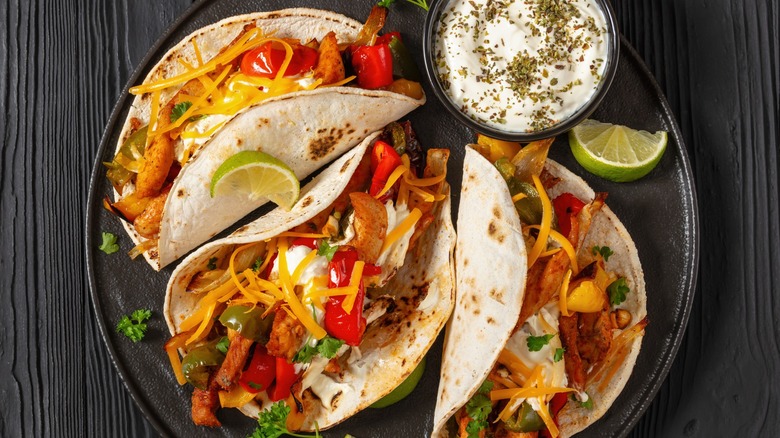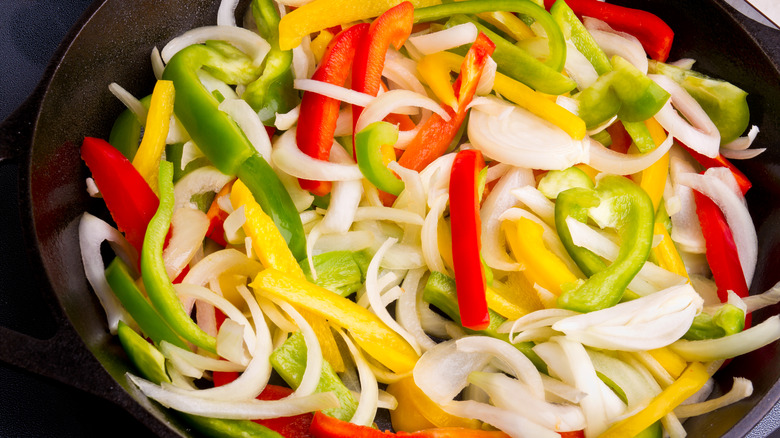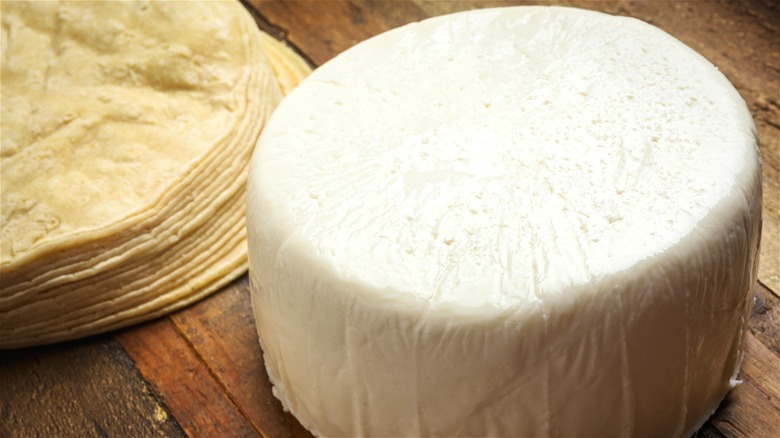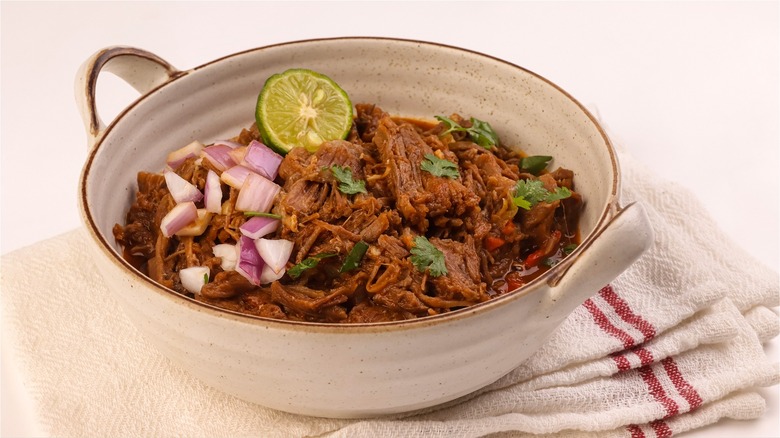13 Ingredient Swaps That Will Make Your Fajitas So Much Better
Fajitas are one of those foods that just make you smile. As it consists of a combination of grilled meat and veggies delivered to your table sizzling hot, accompanied by a pillowy pile of tortillas and an assortment of toppings, this is a dish that pleases pretty much every one of your senses. Fajitas are so well-rounded that it's difficult to think of ways to improve them — but the truth is that most fajita recipes are just a starting point for bigger, better things. By making just one or two ingredient swaps, you can transform this already-delicious dish into something completely revolutionary, and do so with minimal effort.
Because fajitas are made of many different components, the possibilities for ingredient swaps are kinda limitless. You can remove the steak cuts you normally use on fajita night and replace them with lamb, a combination of exciting vegetables, or even cactus. Feel free to try swapping out that rice for an alternative grain, or go lower-carb with riced veggies. Even the tortilla can be changed for something else, with various leaves holding your fillings capably.
With so many swaps at our fingertips, we knew we had to bring in the experts. So we asked chef and restaurateur Raul Luis, owner and operator of Birrieria Chalio, and Melinda Fraser, co-owner of multi-generation, family-owned concept Rodrigo's Mexican Grill. Both of them were generous enough to share their keen knowledge with us, and we're passing it straight on to you.
1. Instead of flour tortillas, use leaves
Fajitas are usually served with flour tortillas, as their soft and pliable nature makes them well-suited to wrapping around various fillings. However, they're far from the only vessel you can use for your fajitas. And, while you can definitely use corn tortillas here, Melinda Fraser and Raul Luis recommend a swap that's even more interesting: Leaves. "Lettuce boats are great alternatives to flour tortillas," says Fraser. By piling your fillings into a lettuce leaf, you give your fajita extra crunch and a pop of moisture, freshening up the meal and giving it a touch of lightness.
There's no need to stop at lettuce, though. "You can use a grilled cactus leaf, which is similar to using a leaf of lettuce to make a taco," explains Luis. "The cactus has a much different taste profile, and if you have not had one before, it will be a great experience to help recalibrate your palate." Cactus leaves have a nutty flavor that's similar to green beans and can imbue your fajitas with a slight earthiness. And, as they're slightly more substantial than lettuce leaves, they can help to give your fajitas a little more heft.
2. Skip the meat and use sautéed veggies
Fajitas are generally centered around meat or seafood, which gives the meal its filling nature and deep flavors. There are times, though, when you just want something a little lighter and fresher — and you don't have to use protein for your fajitas to be tasty. "Veggie fajitas can also be delicious, using ingredients like portobello mushrooms, zucchini, squash, etc.," advises Melinda Fraser. By using these slightly more sturdy, meat-like vegetables, you can give your fajitas the substance they need, while also preventing them from sending you into meat-induced drowsiness.
Other vegetables, like eggplant and cauliflower, can also give your fajitas that meaty nature, while also supplying them with vegetal flavors. Many of these vegetables can also be marinated, giving them a more dynamic flavor profile. As for how to cook them, Fraser points out that it's super simple. "Veggies are best sautéed on a grill, and it is quick and easy to do at home with your favorite oil and seasonings," she says. Sautéing them gives them a charred exterior, which can provide them with a depth that somewhat replicates the flavors of meat.
3. Rather than cheddar or Monterey Jack, opt for an alternative cheese
Your fajitas are nothing without cheese. However, while cheese is non-negotiable for a lot of people, fewer folks think deeply about how the type of cheese they're using will affect their fajitas, and instead are content to grab whatever's in their fridge. Well, we say that it pays to try new things — so skip that cheddar or Monterey Jack, and go for a type of Mexican cheese instead.
"A classic cheese that helps elevate the fajita flavor is queso fresco," says Raul Luis. "This cheese can be put into a taco without melting the cheese, elevating the flavor of the proteins of choice." Queso fresco has a mild, gently salty flavor that's similar to a young feta or halloumi, and this bright saltiness enlivens every bite. Luis also recommends using Asadero cheese, which has a slightly tangy flavor. You should treat it slightly differently from queso fresco, though. "In order to get the most flavor out of it, it should be melted," Luis advises. "You can also mix cheese onto a sizzling fajita plate, and mix it with proteins so that the cheese melts on your meal." Sounds pretty delicious to us.
4. Instead of your regular beans, try chickpeas
Beans do a lot of work in fajitas. As well as providing fiber and protein, thereby making your fajitas more filling and hearty, they also give the dish some nutty notes that stop it from being too one-note. And, if you want to amp up that nuttiness, "garbanzo beans are a good alternative," says Melinda Fraser. Garbanzos have a nutty note that somehow manages to stay light, and they also have a delicious undertone of creaminess that some other beans lack.
Garbanzo beans also have a big impact on the texture of your fajitas. Go for big garbanzos, and you'll give your fajitas way more dynamism, filling each mouthful with big, juicy pops of chickpea. As with other beans, they're versatile enough to go with any flavor or seasoning combo, while still holding their own flavor-wise. Plus, if you really want to amp up that garbanzo flavor, you can try throwing hummus into your fajitas as an alternative to sour cream (or use it alongside sour cream for an ultra-creamy experience).
5. To make fajitas without meat, use cactus
There are plenty of ways to make meat-free fajitas. You can use tofu, seitan, plant-based imitation meat pieces, or just opt for whatever vegetables you have in your fridge. In our opinion, though, all of those ways pale in comparison to what might be our favorite ingredient swap of all time. "For individuals who would like an alternative to meat: cactus fajita," says Raul Luis. There are plenty of types of edible cactus out there, and they have a firm, almost meat-like texture that's accompanied by a mild flavor, making them hugely versatile and pair-able with a host of toppings.
To make this dish, Luis lays out exactly what you need. Begin by grilling your cactus alongside your green and red bell peppers and onions. Then, bring it to the table while still piping-hot, "accompanied with avocado slices, grilled jalapeño, and queso fresco," advises Luis. Sounds pretty delicious, right? Unfortunately, edible cactus can still be a little difficult to find, and while demand for it is definitely growing (which is translating into greater supply), you may have to head to a farmer's market or a specialty food store to find it. If you see it when you're buying your groceries, though, make sure to grab some for your fajitas. You won't regret it.
6. Instead of coriander, throw in some alternative herbs and spices
Finishing your fajitas with a sprinkling of oregano is a time-honored move. With just a flick of the wrist and a dusting of herbs, you can brighten your fajitas up instantly, giving them a zingy herbal flavor that adds way more dynamism to the dish. If you want to create that dynamism in different ways, though, there's a world of other herbs and spices at your disposal. Melinda Fraser recommends using oregano as an alternative, which gives your fajitas a slightly spicier flavor and a bouquet-like fragrance. You can use either fresh or dried oregano here, with dried oregano having a slightly more gentle flavor, and fresh oregano delivering a full-on taste (which can sometimes be a touch overwhelming — you have been warned, folks!).
On the spice front, Fraser says that a dusting of cumin can work wonders. Cumin can give fajitas a deeply perfumed scent and a rich flavor that compliments both red and white meats. When using cumin, it's important to exercise restraint. This spice can seem subtle, but even a dash too much can swamp your fajitas, making them taste too dense.
7. Add freshness and earthiness with riced vegetables
Adding rice to fajitas is a surefire way to make them more hearty — but that heartiness can come at a cost. Not only can rice dull the flavors in your fajitas, but it can also make the dish way heavier, introducing an additional carb that threatens to make you very sleepy. So, if you still want that rice-like texture without the weight, opt for "a confetti rice blend combination of riced broccoli, cauliflower, orange carrots, yellow carrots, and zucchini," recommends Raul Luis. "Finely grated, it's a great, healthy substitute for rice."
You can make riced vegetables easily at home, using a box grater or a plate attachment in your food processor. One of the best things about using this in fajitas is that you can add pretty much any vegetables you have on hand, and it'll still be delicious. Stick with one vegetable and make cauliflower rice, or opt for a blend — it's up to you. You can also use your riced vegetables as a way to add way more flavor to your fajitas. Sauté them with some crushed garlic and your favorite spices before piling them onto your plate. This will also help to soften them, which prevents any chalkiness once they're loaded into the tortillas.
8. For some extra heat, add hot sauce instead of jalapeños
Here's the thing: Not everyone likes jalapeños, guys. We know it sounds wild, but it's true. For some people, jalapeños are just a little too overwhelming, with their vinegary spice taking over any other flavor in the dish. For others, it's a texture issue: They're just not fans of their slightly mushy quality, which can be a particular problem if they've been sitting in a jar in your fridge for months on end.
Don't worry, though. You don't have to sacrifice spiciness in your fajitas if you don't like jalapeños. Melinda Fraser's got the solution: "Adding your favorite hot sauce to the fajitas is a simple and quick go-to." Add a few generous dashes of your preferred hot sauce to your fajita before biting in, or douse your meat and vegetables with it while they're cooking. Vinegar-based hot sauces give you the same flavor notes as jalapeños, and they add additional layers of flavors from the garlic, sugar, and additional spices that are often part of their recipes. Fermented hot sauces, meanwhile, have a funkiness that gives your fajitas more intensity.
9. Instead of sour cream, use cheese sauce or a mixture of toppings
A dollop of sour cream takes fajitas from good to great. The smooth, almost neutral flavor of sour cream helps to temper the spiciness in other parts of the dish, while its tanginess prevents it from being too insipid. However, if you've ever found sour cream a little underpowered, we've got a few delicious solutions. "I recommend a white, melted cheese sauce," says Raul Luis. A simple cheese sauce will give your fajitas all of that smoothness while adding a truckload of funky, salty, savory flavor. "You can also serve it on the side and use it as a dipping sauce for fajitas," Luis notes. Don't mind if we do!
If you don't have it in you to whip up a cheese sauce, Melinda Fraser recommends taking a slightly different approach. "Try pairing both Greek yogurt and guac with your fajitas," she says. Greek yogurt is a step up from sour cream on the tangy front, while guac gives your fajitas all of the earthy, creamy avocado flavors you could want. How you use them is up to you: We personally prefer to mix the two together, making a guac-yogurt hybrid that positively pops with flavor. If you want to keep them separate, though, it's your fajita and we won't tell you what to do with it!
10. Bored of regular cheese? Use a vegan version
Vegan cheese isn't just for vegans, people — it's also for making your fajitas taste even better. "Try one of the many vegan cheese options available," advises Melinda Fraser. "They come in many textures and flavors to meet your preferences." Importantly, some of the best vegan cheeses out there don't exactly replicate the flavor of dairy cheese, and that's kinda a good thing. By obtaining their flavor notes from ingredients like fermented cashews and tofu, they develop a distinct taste that's cheese-like, but slightly lighter. They also avoid any cloying artificial flavors.
As for those varying textures that Fraser mentions? It's true; you can get vegan cheese in pretty much any firmness. If you want something a little softer, go for a vegan cream cheese or a ricotta substitute that you can dollop onto your fajitas like sour cream or spread onto your tortillas. For something a bit more firm, go for a vegan mozzarella-style cheese, or a cheddar substitute. Vegan cheeses usually melt pretty easily, too, and when they do, they can be just as gooey and smooth as the non-vegan kind.
11. Want an alternative topping? Make a quick onion slaw
Fajitas can be on the denser side of Mexican cuisine, with their core ingredients being meat, cheese, and bread. Making them lighter is usually the work of the toppings, and coriander does a lot of the heavy lifting here. However, if you want to generate that same lightness in a bit of a more interesting way, an onion slaw is the way to go.
Making one is a breeze, too. "You cut red onion into thin, long slices, and cut peppers into round, very thin slices, and add freshly squeezed lemon, a pinch of salt, and black ground pepper," says Raul Luis. You can then add in heat by mixing in some jalapeños, serranos, or habaneros: The chili you use depends on how much fire you want, according to Luis. You can jazz it up with more herbs, too. "If you like the taste of oregano, you can add a pinch on the palm of your hands and rub to grind the dry leaves into smaller grains of oregano," Luis states. Once your slaw is ready, load it on top of your other toppings before taking a big old bite.
12. Skip the rice and opt for quinoa
Are you getting bored of plain old rice in your fajitas? We wouldn't blame you. It's delicious, but it can get a little repetitive sometimes. Instead of getting rid of it entirely, replace it with an alternative grain. Melinda Fraser recommends opting for quinoa, which has a decidedly nutty flavor and a slightly bouncier texture than rice.
Different types of quinoa will give you different levels of nuttiness: Black quinoa has the strongest flavor, with red being slightly milder and white quinoa having the subtlest taste. White quinoa also tends to be softest, while red and black quinoa are firmer. If you want the best of all worlds, opt for a combination of all three types by buying tri-color quinoa, and then amp up its flavor even more with some cunning additions.
Importantly, quinoa isn't the only grain you can throw in your fajitas. Bulgur wheat can also give them a rice-like texture and flavor, with a slightly chewy consistency. If you want even more to get your teeth around, try adding cooked barley to your fajitas. Don't forget the potential of sweetcorn in this dish too — yep, it's a grain, folks, and a delicious one at that.
13. Rather than beef or chicken, go for lamb
Chicken and beef are the two most common meats in fajitas, for one key reason: They're delicious. Well, while we're very much an advocate of an "If it ain't broke, don't fix it" approach, swapping out these meats can open up loads of new possibilities. Raul Luis recommends using lamb to make a "Birria fajita, grilled on a griddle with onion, green and red bell peppers, and a consommé broth served on the side." Excuse us while we wipe our drool off the floor.
Birria is a style of meat preparation. It's made by putting pieces of lamb or beef in a pot with a host of spicy aromatics and braising it until it's fork-tender. Doing this with lamb unlocks all of its fatty, gamey flavor, with the spices permeating into the very center of the meat. Transferring these lamb pieces to the griddle and searing them gives them even more depth, and the char they develop pairs beautifully with the rich flavor of the meat. The consommé broth sounds complicated, but it's really a matter of taking the braising liquid, straining it to get rid of any chunky pieces of vegetable or spice, and reducing it until it's the thickness you want. All of this is offset by the freshness of the onions and peppers. Trust us: You'll never make fajitas in the same way again.













